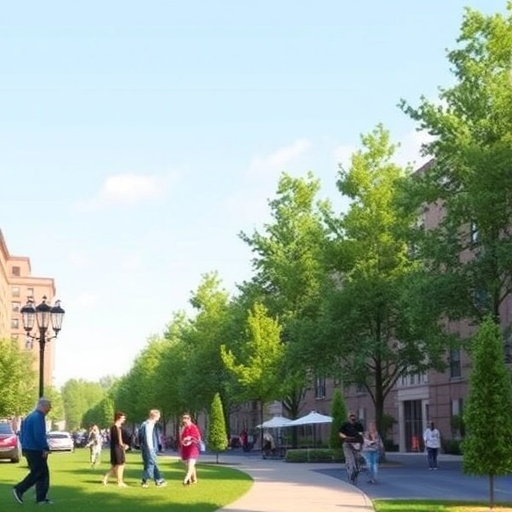Recent research provides compelling insights into the intricate relationship between urban environments and cardiovascular health, particularly among women in midlife. A study led by Rifas-Shiman et al. investigates the associations between street-view greenspace exposure and cardiovascular health indicators, focusing on Life’s Essential 8, a metric developed by the American Heart Association that includes crucial factors such as diet, exercise, weight management, and blood pressure. This study is significant, as it highlights the potential role of environmental factors in shaping health outcomes, especially for women navigating life transitions.
The researchers gathered data from a diverse cohort of women within a demographic that experiences a culmination of biological and lifestyle changes. As women progress through midlife, they face unique health challenges, including increased risk factors for cardiovascular diseases. By evaluating the prevalence of greenspace in urban areas, this study sought to explore whether exposure to such environments could mitigate these challenges by fostering a healthier cardiovascular profile.
Utilizing cutting-edge street-view imagery and algorithms, the researchers measured the quantity and quality of greenspaces accessible to participants. This innovative methodological approach allowed them to quantify exposure in a manner that traditional surveys could not achieve, offering a more accurate representation of women’s daily surroundings. This detail underscores the importance of considering not just the existence of greenspace, but also its visibility and accessibility in relation to urban living.
The study’s findings suggest a promising correlation between greenspace exposure and the health indicators outlined in Life’s Essential 8. Overall, women who reported higher exposure to greenspaces exhibited better cardiovascular health metrics, such as lower blood pressure and cholesterol levels, than those with less exposure. This relationship suggests that the mere presence of greenery in urban settings may contribute meaningfully to reducing health risks, reinforcing the notion that environmental factors play a crucial role in public health.
Interestingly, the effects of greenspace exposure were particularly pronounced in women with varying socio-economic backgrounds. This indicates that enhancing urban greenspaces may serve as a critical public health intervention, especially in underserved communities where access to recreational areas is limited. These findings align with longstanding hypotheses regarding the health benefits of nature, providing tangible evidence that could guide urban planning and public health policies.
Moreover, the analysis took into consideration other confounding factors, such as lifestyle behaviors and socio-demographic characteristics, ensuring that the observed associations were not merely coincidental. This rigorous analytical approach strengthens the credibility of the research and emphasizes the importance of multifaceted strategies when addressing cardiovascular health.
As cities continue to expand and populations grow, the need for sustainable urban design becomes increasingly apparent. This study advocates for integrating greenspaces into city planning initiatives, arguing that doing so could yield significant dividends in public health, especially for vulnerable populations such as women in midlife. Such insights challenge policymakers to think proactively about how urbanization impacts community health and to prioritize environmental interventions alongside medical and behavioral health approaches.
One of the most striking aspects of this research is its implications for community engagement and activism. As communities interpret these findings, there is potential for grassroots movements to advocate for greater access to greenspaces. Activists, urban planners, and public health officials can collaborate to create more vibrant, health-promoting environments that align with the findings of the study. This fosters a sense of agency among residents, empowering them to take an active role in shaping their community’s infrastructure.
Finally, the implications of this research transcend local boundaries, inspiring global discussions about urban health and environmental justice. Cities around the world grapple with similar challenges regarding health disparities exacerbated by urbanization. The insights gathered from the findings in this study might serve as a blueprint for international efforts to incorporate greenspace into urban design, promoting cardiovascular health and addressing social inequalities.
In conclusion, the research led by Rifas-Shiman et al. brilliantly ties together the themes of environmental science, public health, and urban planning. It not only enriches the existing literature on cardiovascular health but also serves as a clarion call for actionable changes in urban environments. As the scientific community continues to explore the links between nature and health, studies like this play a pivotal role in shaping the future landscape of urban health initiatives, particularly for women during midlife when the need for preventive measures is critical.
Subject of Research: Associations of street-view greenspace exposure with cardiovascular health among women in midlife.
Article Title: Associations of street-view greenspace exposure with cardiovascular health (Life’s Essential 8) among women in midlife.
Article References:
Rifas-Shiman, S.L., Yi, L., Aris, I.M. et al. Associations of street-view greenspace exposure with cardiovascular health (Life’s Essential 8) among women in midlife.
Biol Sex Differ 16, 45 (2025). https://doi.org/10.1186/s13293-025-00718-3
Image Credits: AI Generated
DOI: 10.1186/s13293-025-00718-3
Keywords: greenspace, cardiovascular health, Life’s Essential 8, urban planning, public health, environmental health, women’s health.




